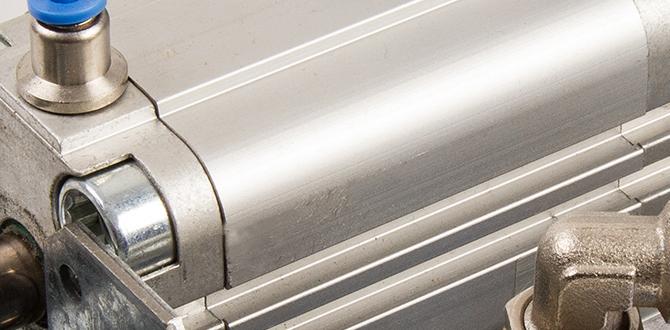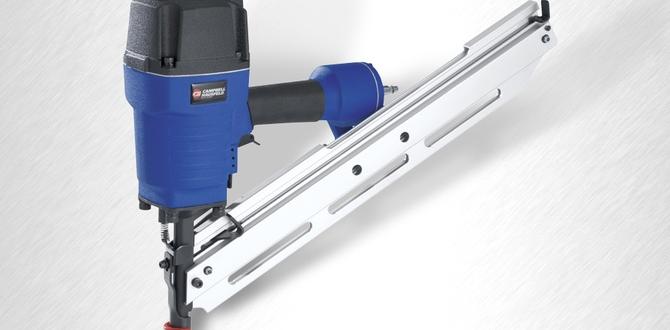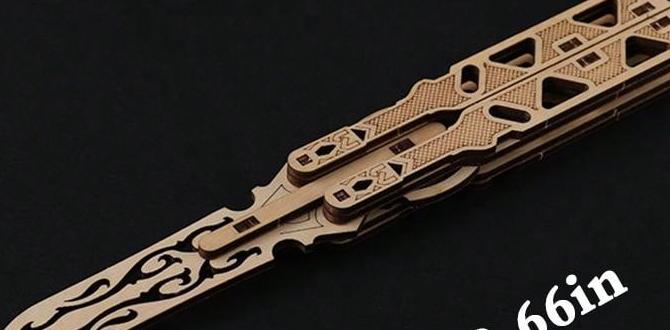What Does Sequential Mode Mean on Nail Guns? It means you can fire one nail at a time, giving you precise control for framing, finish work, and trim. This safety feature prevents accidental firing.
Hey there, fellow DIYers and woodworking enthusiasts! Jack Shaffer here from Nailerguy. Ever picked up a nail gun, ready to tackle that project, only to be a little confused by all the buttons and settings? You’re not alone! One of the trickiest things for beginners is understanding the different firing modes. Today, we’re going to demystify one of the most important: sequential mode. Forget the frustration; by the end of this guide, you’ll know exactly what sequential mode is, why it’s a lifesaver, and how to use it like a pro for all your projects. Let’s get nailing!
Table of Contents
Understanding Nail Gun Firing Modes
Nail guns are amazing tools that can speed up your projects and make them look more professional. But like any powerful tool, they need to be used correctly. They usually come with a couple of different ways to fire nails, and understanding these is key to safety and efficiency. The two main modes you’ll encounter are:
- Sequential Mode (or Single Actuation Mode): This is our main focus today, and it’s designed for precision.
- Contact or Bump Fire Mode (or Rapid Fire Mode): This mode allows you to fire nails rapidly by simply bumping the nose of the gun against the material and pulling the trigger.
While bump fire is great for speed in certain situations (like quickly attaching siding), sequential mode is often the go-to for most DIY tasks, especially for beginners, because it offers a much higher level of control and safety.
What Does Sequential Mode Mean? The Nailer Guy Breakdown
So, what exactly does sequential mode mean on your nail gun? Simply put, sequential mode requires a two-step action to drive a nail. You first need to press the safety contact tip of the nailer firmly against the surface where you want to drive the nail. Once the tip is engaged, you then pull the trigger to fire a single nail. To fire another nail, you must release and re-pull the trigger.
Think of it like this:
- Press: Push the nose of the nail gun onto the wood.
- Pull: Pull the trigger to shoot one nail.
- Repeat: To shoot another, you have to press again, then pull again.
This deliberate, step-by-step process is what makes sequential mode so valuable. It prevents the nail gun from firing unless you actively tell it to, both by positioning the tool and by pulling the trigger. This is a crucial safety feature and a huge help for accuracy.
Why is “Sequential Mode” Called That?
The name “sequential” comes from the sequence of actions required: first the “contact” (pressing the tip), then the “actuation” (pulling the trigger). It’s a sequence that has to happen for each nail.
The Power of Precision: Why Choose Sequential Mode?
As a beginner, or even an experienced woodworker working on detailed projects, sequential mode is your best friend. Here’s why it’s so important and beneficial:
1. Unmatched Safety
This is the biggest win for sequential mode. In contact or bump fire mode, just bumping the nailer can fire a nail. This can be dangerous if you’re not careful where you’re pointing the tool, or if something unexpected happens. Sequential mode dramatically reduces the risk of accidental nail discharge. You have to consciously decide to fire each nail, making it much safer to handle, especially when you’re just getting the hang of things or working in tight spaces. The Occupational Safety and Health Administration (OSHA) provides extensive guidelines on tool safety, and understanding firing modes is a crucial part of that.
2. Pinpoint Accuracy
When you’re building furniture, installing trim, or working on detailed cabinetry, you need to place each nail exactly where you want it. Sequential mode allows you to:
- Position the Nail: You can carefully place the nail gun’s tip at the precise spot for your nail.
- Control the Firing: You then pull the trigger with confidence, knowing only one nail will be fired exactly where you aimed.
This level of control is almost impossible to achieve with rapid-fire modes, where the emphasis is on speed over exact placement.
3. Ideal for Specific Projects
Certain woodworking and DIY tasks absolutely demand the precision of sequential mode. These include:
- Finish Carpentry: Attaching baseboards, crown molding, window casings, and door frames. You want every nail to be perfectly hidden and precisely placed.
- Cabinet Installation: Securing cabinets to walls requires accuracy and should be done one nail at a time for stability.
- Picture Framing and Craftsmanship: Delicate work where a misplaced nail can ruin a piece.
- Any Project Requiring Detailed Placement: Think custom furniture, intricate trim work, or anything where aesthetics are paramount.
4. Learning Curve Friendly
For those new to nail guns, sequential mode offers a gentler introduction. It forces you to slow down, understand the tool’s mechanics, and build good habits. Many nail guns come with sequential mode as the default setting, which is a positive for new users.
How to Use Sequential Mode: A Step-by-Step Guide
Ready to get hands-on? Here’s how to use sequential mode on your nail gun effectively and safely:
Step 1: Safety First!
Before you even think about loading nails, make sure you’re prepped for safety.
- Wear Safety Glasses: ALWAYS. Flying debris and errant nails are serious business.
- Check Your Nailer: Ensure the sequential mode trigger is engaged. Many nailers have a selector switch for the firing mode.
- Understand Your Workspace: Clear the area of anything that could be a hazard.
- Keep Fingers Away from the Trigger: Until you are ready to fire, keep your finger off the trigger.
Step 2: Load the Nails
Refer to your nailer’s manual, but generally:
- Release any air pressure if it’s an air-powered nailer.
- Open the magazine by sliding the follower arm or releasing a latch.
- Insert the correct type and size of nails into the magazine, ensuring they are seated properly.
- Close and secure the magazine.
- If it’s an air-powered nailer, reconnect it to an air source and let it build pressure.
Step 3: Select Sequential Mode
Locate the firing mode selector on your nail gun. It’s often a small switch or button near the trigger. Make sure it’s set to the single-shot, sequential, or actuation/contact mode. Again, consult your tool’s manual if you’re unsure.
Step 4: Prepare Your Workpiece
Position the material you want to nail. Make sure it’s stable and supported.
Step 5: Position the Nail Gun
Bring the nose (the tip of the nailer) of the gun to the exact spot where you want to drive the nail. Press down firmly. You should feel or hear a slight click as the safety mechanism engages with the surface.
Step 6: Drive the Nail
Once the nose is pressed firmly against the material, pull the trigger. A single nail will be driven.
Step 7: Reset and Repeat
To drive another nail:
- Lift the nail gun completely off the surface.
- Re-apply the nail gun to the desired location for the next nail.
- Press down firmly again.
- Pull the trigger.
This repeated sequence of pressing, then pulling, ensures you have control over each nail driven.
When to Consider Other Firing Modes (But Stick to Sequential First!)
While sequential mode is fantastic for precision and safety, there are times when other modes might be used. However, for beginners, it’s usually best to master sequential mode first.
Contact (Bump) Fire Mode
This mode allows for rapid firing. You press the nose and hold the trigger down. As you bump the nailer against the material, it fires nails continuously.
- Pros: Speed. Great for framing, sheathing, or fencing where speed is more critical than pinpoint accuracy for every single nail.
- Cons: Less accurate, higher risk of accidental discharge if not used with extreme care, can cause splintering on delicate materials if not controlled.
Comparing Fire Modes
Let’s break down the key differences in a straightforward way:
| Feature | Sequential Mode | Contact (Bump) Fire Mode |
|---|---|---|
| Action to Fire: | Press tip first, then pull trigger (for each nail). | Press tip and hold trigger; bump to fire (rapidly). |
| Nail Firing Rate: | One nail per trigger pull. | Multiple nails while trigger is held and tip is bumped. |
| Primary Use: | Precision tasks, finish work, trim, safety-critical jobs. | Speed tasks, framing, rough carpentry, decking. |
| Safety Level: | High (requires deliberate actions for each nail). | Lower (requires constant vigilance, higher risk of accidental firing). |
| Accuracy: | High (allows precise placement). | Lower (focus is on speed). |
| Beginner Friendliness: | Excellent. | Requires more practice and caution. |
As you can see, for delicate work, precise placement, and general safety, sequential mode is the clear winner.
Common Nailer Types and Sequential Mode
The good news is that most modern nail guns, regardless of their power source, offer sequential mode.
1. Electric Nailers
These are often battery-powered or corded. They typically have a selector switch for firing modes, and sequential mode is almost always an option for these versatile tools. They are great for indoor projects where you don’t want the fumes or noise of a gas/air nailer.
2. Cordless Nailers (Battery Powered)
These are very popular for DIYers due to their portability. Similar to electric models, battery-powered nailers usually come with user-selectable firing modes, with sequential mode being standard.
3. Pneumatic Nailers (Air Powered)
These are the traditional workhorses, powered by an air compressor. Most pneumatic nailers also include a mode selector to choose between sequential and contact fire. For maximum control and safety, always start with sequential mode. You can find great resources on pneumatic tools and their operation from organizations like the Tool Crib, which often shares industry best practices.
Troubleshooting Common Sequential Mode Issues
Even with sequential mode, you might run into minor hiccups. Here are a few common ones and how to fix them:
- Nailer Not Firing:
- Check firing mode: Is it definitely set to sequential?
- Is the safety contact tip pressed firmly against the surface?
- Is there enough air pressure (for pneumatic)?
- Are there nails loaded correctly?
- Is the battery low or dead (for cordless/electric)?
- Nail Not Driving All the Way:
- Is the wood too dense? You might need a more powerful nailer or shorter nails.
- Is your air pressure too low (pneumatic)?
- Is the battery strength low (cordless/electric)?
- Nailer Firing Continuously (Accidental Bump Fire):
- This usually means the mode selector is accidentally set to contact fire, or there’s a malfunction. Stop immediately, remove air/battery, and check the settings.
Always refer to your specific nail gun’s user manual for detailed troubleshooting steps.
FAQ: Your Top Sequential Mode Questions Answered
Here are some common questions new users have about sequential mode.
Q1: Can I switch between modes on my nail gun?
Yes, most modern nail guns have a selector switch or button that allows you to choose between sequential and contact fire modes. Always check your tool’s manual for specific instructions.
Q2: Is sequential mode always the safest way to use a nail gun?
For most situations, especially for beginners, sequential mode is the safest. It requires deliberate actions for each nail, significantly reducing the risk of accidental firing compared to contact mode.
Q3: What’s the difference between “sequential” and “single shot” mode?
There’s no difference! Sequential mode,” “single actuation mode,” and “single shot mode” are all terms used to describe the same firing mechanism: one nail per trigger pull after the safety tip is engaged.
Q4: Can I use sequential mode for quick framing jobs?
You can, but it will be slower. For framing where speed is a priority and precision for every nail is less critical, many professionals switch to contact (bump) fire mode. However, always prioritize safety, and if you’re unsure, stick with sequential.
Q5: My nail gun has a “contact trigger” and a “mode selector.” How do they work together?
The “mode selector” determines how the nail gun fires (sequential or contact). The “contact tip” or “safety contact element” is the mechanism that must be pressed against the material BEFORE the trigger will fire a nail, in either mode. In sequential mode, you press the tip, then pull the trigger for ONE nail. In contact mode, you press the tip AND hold the trigger; bumping the tip then fires nails RAPIDLY.
Q6: Will sequential mode work on all types of materials?
Sequential mode works on virtually any material a nail gun can drive nails into, from soft woods to hard woods, drywall, and even some composites. The primary benefit is the control over where and when each nail is fired, which is invaluable regardless of the material.
Q7: How do I know if my nail gun is in sequential mode?
Most nail guns will have a visible indicator or a switch that clearly labels “Sequential,” “Single Shot,” or sometimes a symbol showing a single nail being fired. Check the side of the tool near the trigger, or consult your user manual.
Conclusion: Nail Your Projects with Confidence Using Sequential Mode
Understanding “what does sequential mode mean” is a fundamental step in becoming a confident and safe nail gun user. It’s the mode that prioritizes precision and safety, making it the ideal choice for detailed work, finish carpentry, and for anyone just starting out with nail guns. By now, you know that sequential mode requires a two-step process – press the tip, then pull the trigger – for each nail. This controlled firing action ensures your nails go exactly where you intend them to, preventing accidents and improving the quality of your work.
Whether you’re building a bookshelf, installing baseboards, or working on a complex woodworking project, mastering sequential mode will elevate your DIY skills. Remember to always prioritize safety, understand your tool, and consult your user manual. With sequential mode, you’re not just driving nails; you’re building with precision and confidence. So, next time you pick up that nail gun, you’ll know exactly how to use its most controlled and safe setting. Happy building!





